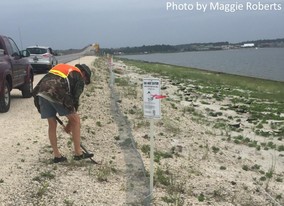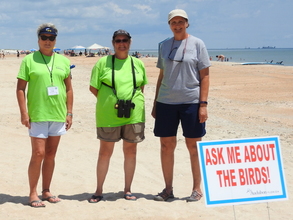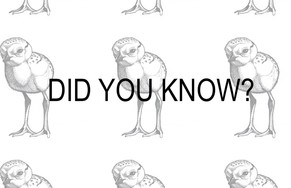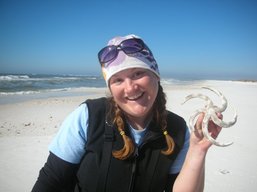Events
July 17: Breakfast with the Birds: The Unseen Army - How Volunteers and Citizen Scientists are Helping Save Our Seabirds. Register at Rookery Bay.
Reminders
July 8-14: The next count window for the Breeding Bird Protocol. If you’re surveying a route with active nesting, weekly surveys help capture information about peak counts.
All Summer: Beach stewards are needed at important beach nesting sites. Check out the map of local stewardship opportunities and contact us to get involved!
 Chateau by the Sea Resort is an Outstanding Conservation Partner for Shorebirds
The Florida Shorebird Alliance recognizes Chateau by the Sea - a proud member of the By The Sea Resorts family - as an outstanding business for their conservation work in protecting state-threatened least terns. The Chateau accommodates one of the largest rooftop nesting colonies in the Panhandle, with over 200 breeding least terns. Each April, when the birds migrate to Florida, the owners allow Audubon and the Florida Fish and Wildlife Commission (FWC) to erect special fencing along the edges of the building to prevent hundreds of chicks from falling off. If a chick does fall off, the Chateau and By The Sea Resorts staff are trained to use a “chick-a-boom”, an apparatus which allows them to safely reunite the baby birds with their parents on the rooftop.
Having a colony of nesting birds on the roof can be messy at times. To say “Thank You” for being amazing hosts, not just to their patrons but to the shorebirds that depend on the rooftop every year, Audubon and FWC are hosting a carwash for resort guests and the public.
The carwash is scheduled for July 2nd, from 9am-12pm at the resort parking lot. If you are interested in volunteering to help with the carwash please email Emily McKiddy. If you are looking for an incredible place to stay in Panama City Beach, you won’t find better opportunity to watch these state-threatened shorebirds raising their young than at the Chateau Resort!
|
 Be a 4th of July Beach Hero!
As people make plans to go to the beach for the Independence Day holiday, the FWC is reminding the public to help protect beach-nesting shorebirds by giving them space and keeping personal fireworks off the beach.
Shorebirds on Florida’s Atlantic and Gulf coasts are nesting now, with many of them watching over flightless chicks. Threatened species such as the snowy plover, least tern, black skimmer and American oystercatcher are among the shorebirds facing conservation challenges and needing help from people to survive. Loud noises can cause adults to flush off their nests and tiny chicks to become separated from parents, leaving them vulnerable to predators, the elements, and getting stepped on by beachgoers.
Be a 4th of July Beach Hero:
- Leave personal fireworks at home and attend an official display instead. The loud sounds and bright lights of impromptu fireworks on Florida's beaches and waterways can have catastrophic effects on nesting birds and their chicks, as well as nesting sea turtles.
- Stay out of posted areas, including Critical Wildlife Areas, and keep your distance from nesting shorebirds and sea turtles.
- Leave Fido at home. But if you walk your dog on a pet-friendly beach, keep it on a leash and at a distance from birds, sea turtles, and their nests.
- Do not feed birds or leave trash, picnic leftovers or fish scraps on the beach. These scraps attract predators that will eat the eggs and hatchlings of birds and sea turtles.
- Boaters also can help protect nesting birds by not getting close to or making loud noises near Critical Wildlife Areas, expanded by the FWC in 2016 and 2017 to protect birds and other species during nesting and other critical life stages. The FWC wants boaters and beachgoers to be aware of the 14 newly designated CWAs, most of them small islands, and not all of them have yet been posted.
Have a safe and happy 4th of July and remember to share the shore!
|
 Community Efforts Protect Navarre Causeway Colony
The Navarre Causeway is a busy bridge that connects the communities of Navarre and Navarre Beach in the Florida panhandle. Heavy traffic along the causeway deters predators, making it an appealing location for black skimmers and least terns to set up a breeding colony every year. Although the birds face less pressure from predators, the traffic poses a difficulty to the flying birds and flightless chicks that make their way into the road. To help the birds navigate this unique location, Santa Rosa County lowers the speed limit to 20mph in the nesting section. Not only does the reduced speed prevent bird/vehicle collisions but it also gives drivers a chance to look at the nesting birds as they drive by.
In addition to the county’s efforts to prevent mortality, Audubon and numerous Navarre, Navarre Beach, and Holley residents install fencing along the perimeter of the colony to prevent chicks from running into the road. In 2018, between 40-50 volunteers installed almost a half-mile of fencing in about an hour. Because of the incredible work of the community, virtually all bird-vehicle chick mortality has been eliminated! In areas where escarpments form after heavy rains, chicks are still able to make their way under the fence. To remedy this, the community is working to prevent the escarpments by placing sandbags in vulnerable areas along the fence line.
The protective measures from the county, Audubon, and local volunteers works very well, and the community has embraced the nesting birds. On behalf of the birds, the FSA thanks the Navarre area community for their ongoing efforts to protect and celebrate nesting shorebirds. If you have further questions about the Navarre Causeway colony or to volunteer, please email Caroline Stahala.
|
 Anastasia State Park’s Least Tern Colonies Successful Despite Challenges
The largest least tern colony in Northeast Florida – and one of the top 5 statewide, is nesting near the southern end of Anastasia State Park in St. Johns County with another smaller colony to the north, also inside the state park. The birds are nesting in an area where 2016 Hurricane Matthew overwashed vegetation creating a broad, sandy platform that first attracted least terns to the park. Hurricane Irma also deposited fresh sand on the site in September 2017, and a beach renourishment project underway has added additional sand to the same area. Since May, the southern site has fledged 96 juveniles and as of June 25th there were 158 active nests in the two colonies combined. Even bigger news is that the black skimmers have returned to nest with the terns for a second year – with seven active nests this year compared to three nests last year!
As with all beach-nesting birds in Florida, disturbance and predation remain challenges to nesting success. To determine the cause of partial colony nesting failures early this season, FWC staff installed game cameras. In May, the cameras photographed two beach-goers walking through the posted area and in early June, a coyote was captured on camera at the south colony. Beginning in mid-June, beach access opened near the south colony after renourishment was completed and dog-walking beach-goers began appearing on the beach near the tern colony despite the park’s policy prohibiting pets on park beaches.
The good news: the birds seem to be winning with continued nesting and juveniles fledging despite challenges. Their success is in part due to 14+ Audubon bird stewards onsite during weekends and holidays to educate beach visitors and reduce disturbances. If you would like to join the stewardship program and help protect nests and chicks with public outreach at beautiful Anastasia State Park, email Jean Rolke, Audubon’s St. Johns County Stewardship Coordinator.
|
 Volunteers Build Chick Shelters for State-Threatened Shorebirds
An incredible group of volunteers armed with power tools, safety glasses, gloves, and a whole lot of ambition spent their afternoon at St. Andrews State Park building chick shelters for threatened shorebirds.
Chick shelters are used as an on‐site conservation tool. They provide cover for flightless chicks that are exposed to predators like gulls and crows, or as protection from extreme temperatures. A total of 15 shelters were completed and will be placed at various State Parks across the Panhandle as well as at busy public beaches like Panama City Beach. The best part is, each shelter is built using recycled materials such as salvaged PVC pipe and outdated plastic signs.
The effort was organized by the Florida Fish and Wildlife Commission and the Florida Park Service. The timing of the shelters are perfect as we gear up for the busy holiday week.
|

 The Florida Shorebird Program is in the middle of refining population estimates. Every survey you submit into the FSD gets used in our analyses, including the surveys that fall outside the Count Windows. Data collected during the count windows give a statewide snapshot (with maximum survey effort) to track birds breeding progress during the nesting season. But more frequent surveys are encouraged and recommended to better track population numbers and nesting outcomes.
Whether you’re surveying only during the count windows, weekly, or even more frequently we will use your data! All data submitted to the FSD is valuable and used to inform and identify research needs, and opportunities for management, conservation, and protection of shorebird species in Florida.
Thank you for continuing to be a vital part of the shorebird monitoring network!
|
 Welcome Back, Bobbi Carpenter!
We're thrilled to announce Bobbi Carpenter has returned to the FWC as the new Shorebird Program Data Quality Manager. Bobbi is a familiar face to many partners in the Florida Shorebird Alliance, having worked for FWC in a variety of capacities over the past nine years. Bobbi was involved with numerous monitoring and research projects working with shorebirds, including the red knot, American oystercatcher, and piping plover. Bobbi was also involved in the original development of the breeding and nonbreeding shorebird protocols, invertebrate sampling protocol, and Florida Shorebird Database (FSD) design and application development.
Bobbi’s professional experiences are diverse; she has experience working with data through the complete data life cycle, including project design and development, field data collection, database development, quality control, data analysis, mapping, report and manuscript writing, and public outreach. The breadth of Bobbi’s skills are a tremendous asset as she takes on the role of Data Quality Manager.
Welcome back!
|
 Happy Birthday, Red R5!
This year marks the 10th anniversary of the commencement of American oystercatcher research in Florida and the banding of the first oystercatcher with a unique red band with the code ‘R5’. It was banded according to the cooperative banding protocol adopted by all researchers in the American Oystercatcher Working Group. Banding activities were permitted by the Bird Banding Lab (permit #21980). By individually marking birds using color bands we can determine dispersal and movement patterns, survival, as well as breeding and wintering site fidelity. This information guides management and conservation efforts for the oystercatcher in Florida and the rest of its range.
R5 was banded as a chick on the Amelia River (Nassau County) in 2008. When it was a young bird it did a quick foray to North Carolina then it settled back in Florida in 2011 on its current breeding grounds along the Tolomato River (St. John’s County). It has successfully raised many chicks on the same rake along the river and just a week ago the research crew was able to capture and band R5’s latest chick Red ‘Y40’. You can find R5 along the river year-round, unlike some of its banded neighbors who head to Central America for the winter. In recent years, coordinated, widespread banding and re-sighting efforts throughout the oystercatcher’s range have revealed connections between breeding and wintering sites and a glimpse into the complexity of patterns of movement and dispersal. We look forward to continuing to track R5, Y40 and our other Florida banded American oystercatchers.
|
|